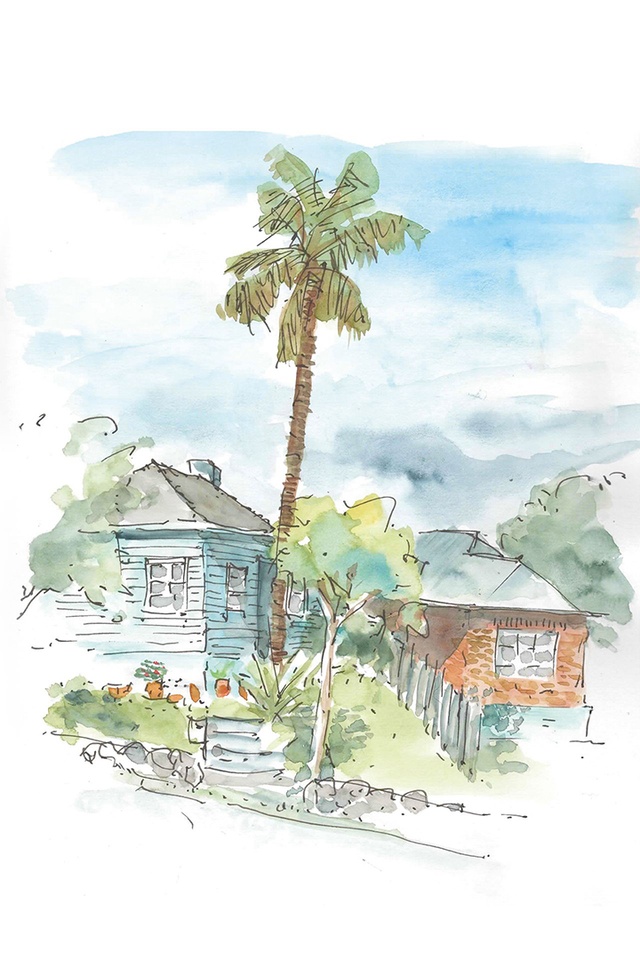An obvious and sound investment
Pip Cheshire believes dry, secure and affordable housing should be part of our national infrastructure, and that the crux of the housing issue lies in inherited social constructs.
In the empty airewaves of the early 1960s, my album of Dick Dale’s guitar was a rare treat. It’s insistent reverb-laden Stratocaster all but smelt of the rush and power of surfing. It fuelled the busting-out of a marginal activity practised by a relatively few bleached-blonde beach bums and cemented California as the epicentre of a beach-focused cultural phenomenon, and burgeoning new industry. Much later, I read an interview with Dale describing his retreat into the Mojave Desert and reluctance to come below 1500 feet above sea level for fear the San Andreas fault-line would shift, precipitating an earthquake in which he might be caught.
I was musing about the role of the high desert as a place of refuge and retreat, much as the possibility of ‘going bush’ for many in Aotearoa is a reassuring possibility should the shit, in whatever form it might take, hit the fan. Critical to the cleansing and restorative powers of one’s refuge, be it the dense Kiwi bush or the parched Californian desert, is its unsullied nature: that it offers immersion in an unmodified landscape.
The provocation for my musing was an article describing the impending sale of the so-called ‘invisible house’ at Joshua Tree, that wonderful bit of the Mojave Desert eulogised in U2’s 1987 album. The house is a long, narrow, rectangular extrusion, clad entirely in mirrored glass, reflecting the tawny landscape and making a reasonable job of concealing the paraphernalia of aircon, sewerage, etc. It is, though, a conceit, a fanciful piece of merchandising, able to be hired by the hour for filming, events and ‘intimate occasions’. It is not a house, and it is not not there. It is also ‘drawing a long bow’ to suggest it has less impact on the landscape than the eclectic collection of neighbouring buildings one finds in that farthest reach of LA’s orbit.
I have seen an American client sit bug eyed in our Environment Court as appellants from far and wide laid claims of all manner of interest over their patch of Aotearoa, land they were repairing from the ravages of a bulldozer-crazed Kiwi cow cocky former owner. In contrast, the house at Joshua Tree has the advantage of sitting within a jurisdiction within which property rights are sacrosanct and the arguments of our local appellants would receive short shrift, if indeed there were a forum within which they might be heard.
My client’s indignation at the presumed right to intrude on his plans by what to him seemed every man and his dog clearly illustrates that, in contrast to his home country, we place greater weight on society’s rights than those of the individual. The implicit social contract that privileges collective welfare over the rights of the individual is a philosophy that has informed much of the country’s politics in the last hundred years and powered the establishment of our once much-vaunted health, education and welfare arrangements in the early and middle parts of the 20th century.
There is, however, plenty of evidence that the social contract which accepted big government’s critical role in nation-building and providing for the well-being of its citizens is under threat, if not broken. We have not yet reached the stage of my client’s country, in which the very structure and operation of government seems increasingly eroded by a polity hell-bent on undoing the very reason individuals gathered to form cities, states and countries. At issue is whether or not an ordered society has a greater ability to foster, support and protect its citizens through shared collective endeavour than an aggregation of individuals freed from the constraints of intrusive government and acting alone.

Though the occupation of the Beehive lawn was somewhat more genteel than the storming of Washington’s Capitol building, it was positive proof of similar disenchantment and antipathy towards the ‘nanny state’, a derisive description suggestive of excessive government involvement in our lives. The degree of government activity is, like most things these days, a spectrum within which we slide, according to the vicissitudes of one or another political party’s fortunes at the polls. At one end is the centralised apparatus of state planning and, at the other, the creation and distribution of wealth through mechanisms of the ‘unseen hand’ of the market.
The terrible Russian death toll as a result of Stalinist land collectivisation programmes is an extreme example of the failure of a too-great reliance on centralised planning. In contrast, the highly stratified US health system offers the possibility of the very best of medical intervention yet leaves a large percentage of its population unable to afford access to even basic care.
In the dichotomy between individual and collective reward, we have typically chosen to have a ‘couple of bob each way’, successive governments identifying desirable outcomes and tinkering with market mechanisms to achieve them. Nowhere is this more apparent than in the provision of housing in which the industry built around its commodification looms so large that writer Bernard Hickey has described our economy as “a housing market with bits tacked on”.
The access to, and quality of, housing underlies many of the country’s social issues: the prevalence of respiratory and other illnesses more common in underdeveloped countries, unstable occupation leading to inconsistent schooling and employment, social alienation and crime, among many other impacts. The inequitable distribution of housing that has too many of our fellow citizens living in appalling conditions just across the tracks from sprawling suburbs of McMansions is an indictment of the faith in the market to sort out who gets what.

As Auckland City Missioner Helen Robinson said at the first Urban Room session last year, the economic system that allows thousands in the city to be either unhoused or poorly housed results from a system that we have made: one that implicitly accepts poor health, intergenerational poverty and crime as the cost of our inequitable affluence. This is a social construct that we might consciously change were we to set aside our use of housing as sort of ersatz money, a store of value, and see the provision of dry, secure and affordable
housing as a component of national infrastructure, as critical to building our country’s wealth as is a hydro dam or an efficient and safe roading system.
It is unconscionable that we allow this situation to continue. Were the same benefit–cost ratio analysis applied to housing as that applied to spending on new roading, costing all the negative health, crime and related consequences of substandard housing, public investment in housing would be an obvious and sound public investment.
Many architects do outstanding work ensuring that projects undertaken by those agencies engaged in public social housing are well designed and of reasonable construction standard, but the provision of high-quality, affordable housing and the pathways to providing secure tenancy for occupiers will not be resolved in the nation’s design studios. It’s time for government to set aside minor manipulations of market mechanisms and seize the day, let private enterprise build but open the public purse and cut out usurious funding institutions. We have done it in the past, and it’s time to do it again; put down your pencils and mice and go lobby a candidate.










